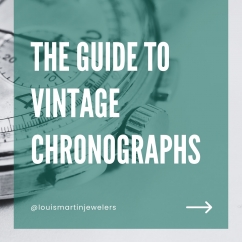Articles and News
Louis Martin Jewelers Offers Insight into the Value of Vintage Chronographs August 28, 2024 (0 comments)

New York, NY--Louis Martin Jewelers took to Facebook to share a guide detailing vintage chronographs' history, mechanics, and unique characteristics.
[Image via Louis Martin Jewelers/Facebook]
Originally designed to measure elapsed time, these watches have evolved into sought-after items among collectors for their blend of functionality and historical significance.
A vintage chronograph functions as a stopwatch within a wristwatch, using mechanisms that allow users to measure time intervals. Many vintage models feature manual or automatic movements that require regular winding and maintenance. These intricate mechanisms reflect the craftsmanship of the periods in which they were created.
The jeweler's post states that an important feature of vintage chronographs is the patina that develops on the watch's dial, hands, and case over time. This aging process results in distinct changes in color and texture, giving each timepiece a unique appearance. Collectors highly value these variations, known as patina.
The design of vintage chronographs varies significantly by era. Models from the 1940s often have minimalist dials, while those from the 1970s are known for bolder designs. Elements like tachymeter scales, telemeter markings, and multiple sub-dials contribute to their functionality and appeal.
Louis Martin Jewelers highlights the Mathey Tissot 1940's Stainless Steel Chronograph as a notable vintage timepiece. This model, known for its well-preserved movement and aged patina, represents the appeal of these watches.
According to the guide, understanding the specific features of vintage chronographs can help collectors appreciate their value and historical significance.
Learn more in this post by Louis Martin Jewelers.







